
Samsung is Considering Integrating Cameras into its S Pen
Samsung has designed an S Pen with an integrated smartphone camera that would give its Galaxy line of phones more ways to capture photos.

Samsung has designed an S Pen with an integrated smartphone camera that would give its Galaxy line of phones more ways to capture photos.

Vivo has designed a smartphone camera that detaches from the main body of the phone and takes a piece of the display with it, a curious design decision that allows the main cameras to be used for selfies... and more.
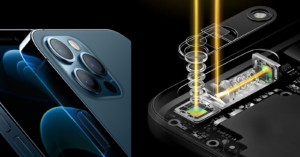
Apple has been beaten to the periscope "folded" camera punch by pretty much every other smartphone manufacturer, but it continues to design and patent new takes on the now-commonplace tech. It was granted a patent for a new design that includes folded optics and "lens shifting" capabilities.

Canon has designed a system that makes it easier and more reliable to capture high-dynamic-range (HDR) photos by better pairing an in-body image stabilization (IBIS) with shake detection algorithms that actively correct for changes in a scene at the point of capture.
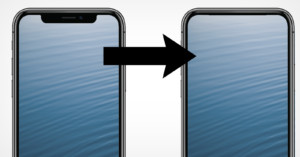
Apple has recently patented an unusual method for dealing with the much-maligned "notch" that contains its front-facing camera. Rather than use a system that places the camera under the display, Apple instead has designed a moving "window" that can open to reveal a camera behind it.

Samsung has been granted a patent for what it is described as a camera with a moveable construction. The three cameras in the array are arranged in a T-shape and a motorized gear moves them in a sliding motion, which changes their aperture in the process.
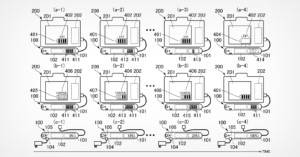
Canon has filed a patent for a system that expands the battery indicator of a camera to also display the remaining life of a connected USB-C battery supply.
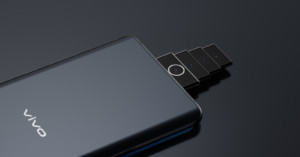
Chinese smartphone manufacturer Vivo has recently published schematics for a pyramid-like smartphone camera design that stacks multiple lenses on top of each other in a unique telescoping camera mechanism.

Canon has filed a patent for a new "image pickup-up device and adjustment mechanism" that appears to be a high-powered clip-on-style telephoto camera accessory for smartphones.
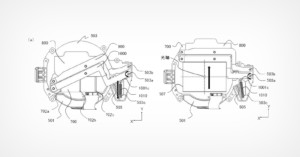
Canon has filed a patent for a new shutter-like barrier mechanism that appears designed to protect the shutter and image sensor of its mirrorless cameras when a lens is removed, ensuring that no dust or debris can enter and cause damage.

Nikon looks set to launch what is likely the first consumer camera to use GNSS instead of GPS. It would be a major upgrade in how geolocation coordinates are obtained for the metadata of photos.

Multiple manufacturers are currently attempting to solve problems with a smartphone's front-facing camera. Current devices generally use a notch or hole-punch, but to keep a display seamless some are trying to hide them under the display itself. Xiaomi thinks there might be a better way.
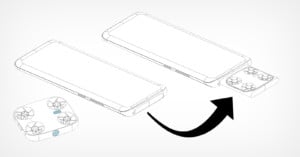
Vivo is reportedly developing a smartphone that includes a tiny quadcopter drone that slides out from the main body of the device, detaches, and can fly away to allow for better selfie photos.
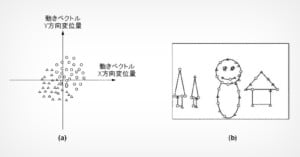
Canon has applied for a patent that would use an in-camera algorithm in tandem with the camera's image stabilization system to intelligently determine the difference between blur caused by motion and blur caused by a moving subject, and correct it.

According to a report from LetsGoDigital, the Chinese smartphone company Xiaomi has patented three new smartphone designs with huge camera arrays developed in a collaboration with Samsung.

Microsoft has patented a new "logo camera" system for use on its devices. It uses a quad-camera array in the shape of its iconic Windows logo where each individual camera is optimized for a specific color.

Efforts to reduce bezels and notches at the top of smartphones are impeded by one major must-have feature: the front-facing camera. While many Android devices have adopted the "hole punch" over the iconic Apple notch, Google may be headed towards a unique under-display camera.
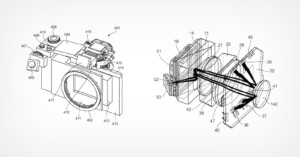
In a patent, Canon explains how it intends to translate its Eye-Control Autofocus (AF) technology into a camera with an electronic viewfinder (EVF). The technology was originally developed for the EOS 5 SLR, and as such needed updating.
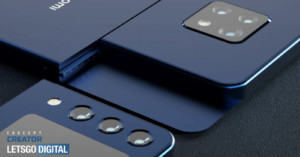
In a play on smartphone design that would make them much more like traditional cameras, Xiaomi has patented a modular smartphone that would accept interchangeable nodes, each one with different functions.

Canon has applied for a patent that would allow a camera to use its in-body-image-stabilization (IBIS) to approximate the effects of an anti-aliasing filter. The idea is similar to how sensor-shift multi-shot works, but in reverse.
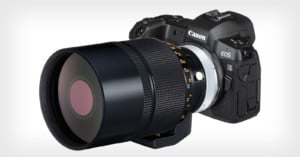
A newly published patent suggests that Canon might be trying to bring a catadioptric optical system back to its camera lens lineup. If the "mirror lens" designs do materialize, we would likely see super telephoto lenses that are much smaller and cheaper than equivalent Canon lenses currently on the market.

Photographer Erik Espinosa was tired of fighting with his own reflection when it came to shooting shiny products and decided there had to be a better way. Fresh off an approved patent, his new domed box concept calls "Entero" removes that problem entirely.
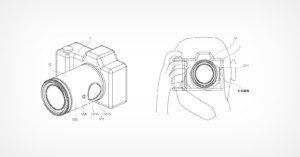
Canon has recently been thinking out of the box with its experimental camera lines, but a new patent filed in Japan shows the company isn't afraid to try new things with more conventional camera equipment either. The designs show an interchangeable lens with a large, circular touchpad.

Ken Rockwell has announced that he has patented a software addition that would leverage the ability for full-frame cameras to shoot in crop modes and automatically apply that feature when a lens is zoomed for extra optical throw in situations like bird photography.
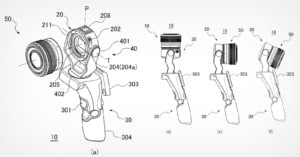
Canon has patented a handheld camera that combines a design reminiscent of the DJI Osmo (now called the OM) with its RF lenses and a rotating hinge. The flipping lens hinge is described as making it much easier to switch between forward-facing and selfie views.
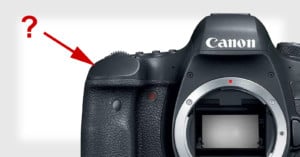
Shutter buttons have been an age-old feature of cameras, and it's one that hasn't seen too much innovation over the years, but it seems Canon is working to reimagine what the button could be like... by removing the button altogether and replacing it with a shutter touchpad.
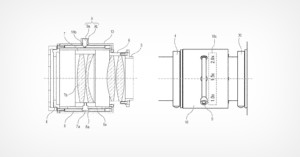
Canon has patented a rather unusual product: a variable, zoomable 1.0x-1.5x-2.0x teleconverter that changes by moving a lever. Based on the design, it's likely that a lens like the RF 100-500mm would be compatible with it.
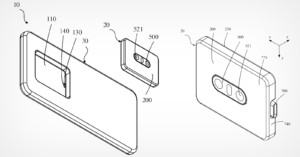
Needing to use a lower-resolution front-facing smartphone camera for selfies and video calls might be a thing of the past if Oppo acts on a recently-filed patent. The design within features a rear camera module that separates from the main camera body.
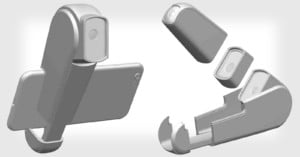
A new patent has been unearthed that reveals yet another strange camera design from the folks at Canon. Following in the footsteps of the "clippable" IVY REC and monocular Powershot Zoom camera, this particular creation would be a smartphone camera attachment that lets you swap in various lenses.

A patent recently that was recently unearthed purports to show a high-end drone camera that Olympus has been working on. PetaPixel has obtained the full patent application, which describes a camera system that would feature a high-end zoom lens and high-performance sensor.

A newly discovered Apple patent reveals what the "group selfies" could look like in a socially distanced world. The feature is described as a "a synthetic group selfie," where multiple people submit images or video of themselves, that your iPhone can then stitch together using software.
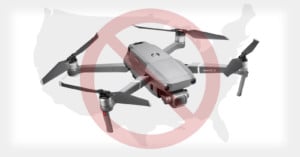
A US judge has ruled that Chinese drone juggernaut DJI violated the patent of a smaller drone maker, and he is recommending that most DJI drone models be pulled from store shelves and blocked from being imported.
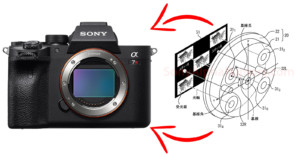
A Japanese patent from Sony hints at a future lens that would allow you to shoot first, and focus your photos later. By combining multiple smaller lenses into a single larger lens, the idea could open up a world of new imaging possibilities if it ever comes to pass.
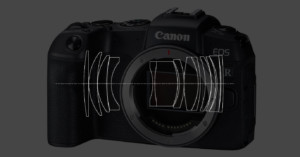
Canon News has uncovered a new patent out of Japan that shows some of Canon's potential plans for the RF lens mount. According to the patent, Canon is looking into releasing some more affordable RF prime lenses like an 85mm f/1.8 and a 100mm f/2.8.
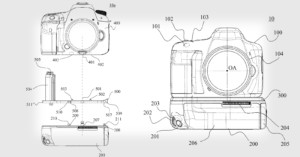
A newly discovered Canon patent has photographers wondering why nobody thought of this before. The US Patent, filed on August 30th and published today, shows the company is working on a universal battery grip that could be fitted to multiple cameras using an adapter.
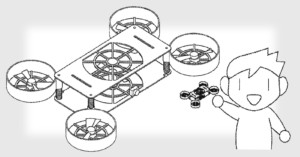
Sony has been quietly developing and patenting a "flying camera" drone over the past few years. While not much is known about the project, the published patents (titled "Flying Camera and a System") reveal some interesting features of the device.

The design of the iMac hasn't changed much since the aluminum unibody version was announced in 2009. They slimmed down the design in 2012, and added a retina display in 2015, and that's about it... but that definitely doesn't mean Apple isn't innovating behind the scenes.

A reliable report from Canon Rumors, as well as a newly discovered patent, has revealed some of Canon's exciting plans for the RF Mount. Not only is a nifty fifty 50mm f/1.8 lens in the works, the company is also working on a pancake lens and has designed a 135mm f/1.4L.
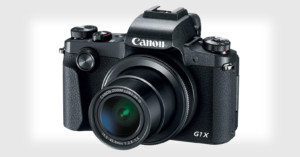
Canon News has uncovered a fresh patent that shows Canon working on a dual IBIS + Lens IS system for its more affordable, entry-level cameras like the EOS M and PowerShot series.
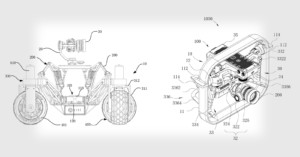
Chinese drone company (and Hasselblad owner) DJI may be bring their ambitions back down to Earth, literally. A newly discovered patent granted to the company shows a land-based vehicle with a camera and gimbal mounted on top—sort of like a pared down version of one of the Mars rovers.